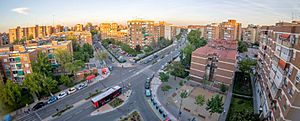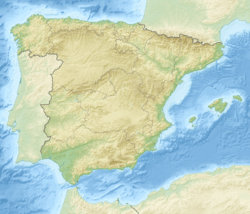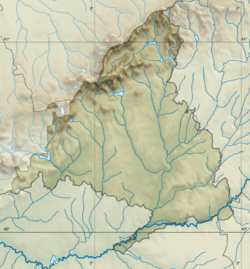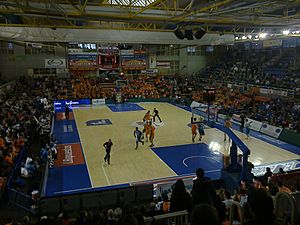Fuenlabrada facts for kids
Quick facts for kids
Fuenlabrada
|
|||
|---|---|---|---|
 |
|||
|
|||
| Country | Spain | ||
| Region | Community of Madrid | ||
| Area | |||
| • Total | 39.41 km2 (15.22 sq mi) | ||
| Elevation | 664 m (2,178 ft) | ||
| Population
(2018)
|
|||
| • Total | 193,586 | ||
| • Density | 4,912.1/km2 (12,722.3/sq mi) | ||
| Time zone | UTC+1 (CET) | ||
| • Summer (DST) | UTC+2 (CEST) | ||
| Postal code |
28940-28947
|
||
| Website | www.ayto-fuenlabrada.es | ||
Fuenlabrada is a lively city and municipality in Spain. It is located in the Community of Madrid. As of 2018, nearly 200,000 people live there. This makes it the fourth largest city in the region.
Contents
What's in a Name?
The name Fuenlabrada comes from two Spanish words. These are Fuente Labrada. This means "carved fountain" in English.
Where is Fuenlabrada?

Fuenlabrada is not completely flat. The highest point is 721 meters above sea level. This spot is on a hill in the northwest part of the city.
The city's height slowly goes down from northwest to southeast. The lowest parts are in the east. They are just over 600 meters above sea level. These areas are near the border with Getafe.
A very large business area is in the southeast. It is called Polígono Cobo Calleja. This area mostly handles wholesale goods from China. It is thought to be the biggest of its kind in Europe.
The residential area of Loranca is in the west. It is close to Móstoles. A highway separates it a bit from the main city.
The main stream here is the Arroyo Culebro. It flows into the Manzanares River. Other streams in the area flow into the Guadarrama River.
A Look at History
People have lived in the Fuenlabrada area for a very long time. Archeologists have found signs of human life from the Paleolithic (Stone Age). They also found things from the Bronze Age.
The village of Fuenlabrada likely started in the late 1300s. People from nearby small towns moved here. These towns included Loranca, Albas, and Fregacedos.
Fuenlabrada was first officially mentioned in the 1500s. This was during the time of King Philip II. The village lost many people in the late 1700s.
Farming was the main job for a long time. But by the late 1800s, Fuenlabrada became known for its tasty rosquillas (ring-shaped pastries) and buns.
After the Spanish Civil War (1936–1939), parts of Fuenlabrada were damaged. The government helped rebuild the city in the 1940s and 1950s.
The city's population grew very fast in the 1970s. It went from about 7,000 people in 1970 to over 65,000 in 1980. This was the biggest growth in Spain at that time! The population kept growing in the years after.
Since 1979, the Spanish Socialist Workers' Party (PSOE) has been very popular here. Fuenlabrada is part of the "red belt" around Madrid. This means many people in these areas support the PSOE.
Getting Around Fuenlabrada

Roads
Fuenlabrada is connected to several major highways. These include the M-50, A-42, M-506, M-407, and M-409. Local roads also link it to nearby towns.
Metro
Fuenlabrada has great public transport links to Madrid and other cities. The Madrid Metro line 12, called Metrosur, serves Fuenlabrada. It has five stations in the city:
- Loranca
- Hospital de Fuenlabrada
- Parque Europa
- Fuenlabrada Central (you can change to the commuter train here)
- Parque de los Estados
Commuter Train
The Cercanías Madrid line C-5 connects Fuenlabrada to Madrid. This is a special commuter train service. Fuenlabrada has two stations for this train:
- Fuenlabrada (you can change to the Metro here)
- La Serna
How Many People Live Here?
Fuenlabrada's population grew very quickly in the 1980s. Many young workers moved here from Madrid and other farming regions. They came looking for more affordable homes. These workers often came from places like Extremadura, Castilla-La Mancha, Andalusia, and Galicia.
By 1975, the city already had over 18,000 people. Today, people from all over the world live in Fuenlabrada. Many come from Latin America, Africa, China, and Romania.
Learning in Fuenlabrada
Schools for Kids and Teens
Fuenlabrada has many schools for young people. There are 33 kindergartens and daycare centers. It also has 50 primary schools and 15 secondary schools.
University Education
The Universidad Rey Juan Carlos (URJC) has a campus in Fuenlabrada. Here, students can study many subjects. These include communication, engineering, tourism, and business.
The National University of Distance Education (UNED) also has a branch in the city. This allows people to study from a distance.
Sports in the City
Fuenlabrada is home to a professional basketball team. It is called Baloncesto Fuenlabrada. They play in Spain's top basketball league, the Liga ACB. Their home games are played at the Polideportivo Fernando Martín sports center. This center can hold 5,700 fans.
The local football (soccer) team is CF Fuenlabrada. They play in the Primera Federación, which is the third level of Spanish football. Their home stadium is the Estadio Fernando Torres. It was opened in 2011 and can hold 7,500 people.
In the early 1990s, a famous basketball team from Serbia, Partizan, played their home games in Fuenlabrada. This was because of a conflict in their home country. That season, they actually won the European championship!
Sister Cities
Fuenlabrada has special friendships with other cities around the world. These are called "sister cities."
Famous People from Fuenlabrada
- Roberto Jiménez (born 1986), a professional football player.
- Fernando Torres (born 1984), another professional football player.
Images for kids
See also
 In Spanish: Fuenlabrada para niños
In Spanish: Fuenlabrada para niños








